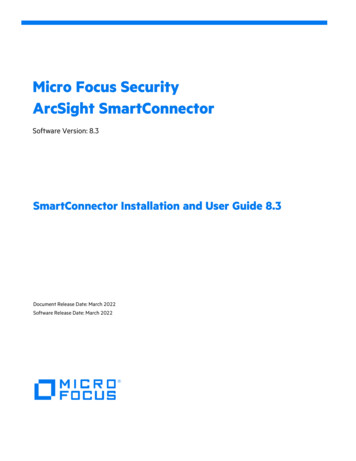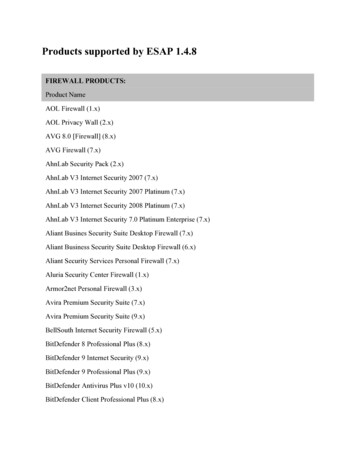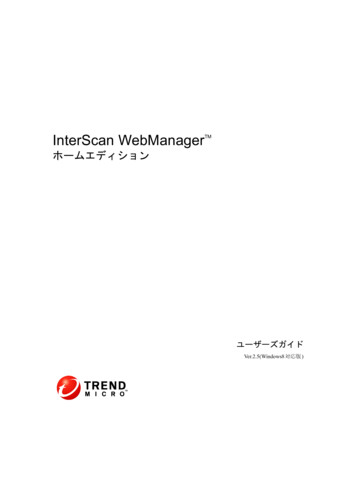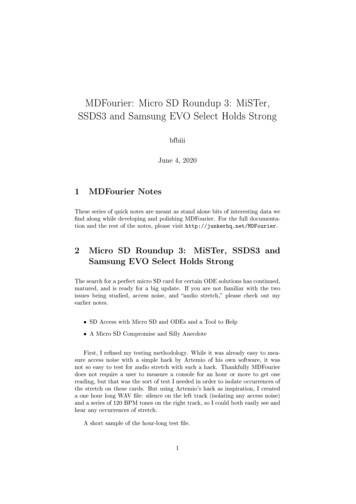
Transcription
Micro Focus SecurityArcSight SmartConnectorSoftware Version: 8.3SmartConnector Installation and User Guide 8.3Document Release Date: March 2022Software Release Date: March 2022
SmartConnector Installation and User Guide 8.3Legal NoticesMicro FocusThe Lawn22-30 Old Bath RoadNewbury, Berkshire RG14 1QNUKhttps://www.microfocus.comCopyright Notice Copyright 2022 Micro Focus or one of its affiliatesConfidential computer software. Valid license from Micro Focus required for possession, use or copying. Theinformation contained herein is subject to change without notice.The only warranties for Micro Focus products and services are set forth in the express warranty statementsaccompanying such products and services. Nothing herein should be construed as constituting an additional warranty.Micro Focus shall not be liable for technical or editorial errors or omissions contained herein.No portion of this product's documentation may be reproduced or transmitted in any form or by any means, electronicor mechanical, including photocopying, recording, or information storage and retrieval systems, for any purpose otherthan the purchaser's internal use, without the express written permission of Micro Focus.Notwithstanding anything to the contrary in your license agreement for Micro Focus ArcSight software, you mayreverse engineer and modify certain open source components of the software in accordance with the license terms forthose particular components. See below for the applicable terms.U.S. Governmental Rights. For purposes of your license to Micro Focus ArcSight software, “commercial computersoftware” is defined at FAR 2.101. If acquired by or on behalf of a civilian agency, the U.S. Government acquires thiscommercial computer software and/or commercial computer software documentation and other technical data subjectto the terms of the Agreement as specified in 48 C.F.R. 12.212 (Computer Software) and 12.211 (Technical Data) of theFederal Acquisition Regulation (“FAR”) and its successors. If acquired by or on behalf of any agency within theDepartment of Defense (“DOD”), the U.S. Government acquires this commercial computer software and/or commercialcomputer software documentation subject to the terms of the Agreement as specified in 48 C.F.R. 227.7202-3 of theDOD FAR Supplement (“DFARS”) and its successors. This U.S. Government Rights Section 18.11 is in lieu of, andsupersedes, any other FAR, DFARS, or other clause or provision that addresses government rights in computer softwareor technical data.For information about legal notices, trademarks, disclaimers, warranties, export and other use restrictions,U.S.Government rights, patent policy, and FIPS compliance, see https://www.microfocus.com/about/legal/.Trademark NoticesAdobe is a trademark of Adobe Systems Incorporated.Microsoft and Windows are U.S. registered trademarks of Microsoft Corporation.UNIX is a registered trademark of The Open Group.Documentation UpdatesThe title page of this document contains the following identifying information:lSoftware Version numberlDocument Release Date, which changes each time the document is updatedlSoftware Release Date, which indicates the release date of this version of the softwareMicro Focus SmartConnector (8.3)Page 2 of 183
SmartConnector Installation and User Guide 8.3To check for recent updates or to verify that you are using the most recent edition of a document, go /documentationSupportContact InformationPhoneA list of phone numbers is available on the Technical SupportPage: ntact-informationSupport Web ht Product ion/arcsight/Micro Focus SmartConnector (8.3)Page 3 of 183
SmartConnector Installation and User Guide 8.3ContentsOverview of SmartConnectors10SmartConnector FeaturesData CollectionData EncryptionImportant:Event Filtering and AggregationFilteringAggregationUnique Generator IDData Mapping to Vendor EventsFIPS ComplianceFIPS Suite BFIPS Compliant ConnectorsFIPS Non-Compliant SmartConnectorSmartConnector Not Certified as FIPS Compliant1112121313131414151516161616Types of SmartConnectorsAPI ConnectorsDatabase ConnectorsFile ConnectorsFlexConnectorsMicrosoft Windows Event Log ConnectorsModel Import ConnectorsOther ConnectorsConnectors that Use Multiple MechanismsConnectors that Use TCP in Special FormatsScanner ConnectorsSNMP ConnectorsSyslog Connectors16171718181919202020202121Types of DestinationsArcSight Manager (encrypted)ArcSight Logger SmartMessage (encrypted)ArcSight Logger SmartMessage Pool (encrypted)Sending Events from Logger to a ManagerSending Events to Both Logger and a ManagerSending Events to Logger54545455555657Page 4 of 183
SmartConnector Installation and User Guide 8.3Forwarding Events from ESM to LoggerAmazon S3CEF FileCEF SyslogCEF Encrypted Syslog (UDP)CSV FileRotating Event DataMicrosoft Azure Event HubTransformation HubRaw Syslog58595960606161626264SmartConnector Installation OverviewDeployment ScenariosScenario 1: Connectors Reside on Three Different DevicesScenario 2: Connectors Reside on a Host MachineScenario 3: Connectors Reside on ESM ManagerScenario 4: Connectors are Configured to Send Events to LoggerIdentifying ArcMC Deployment ScenarioArcSightLoggerArcSight ESMESM and Logger65656566676868686868Planning to Install and DeployInstallation ChecklistReviewing the Considerations and Best PracticesUser Privileges When Installing (UNIX only)When Running As a ServiceWhen Running in Standalone ModeEstimating Storage RequirementsUnderstanding the Turbo Mode7070717272747575Installing SmartConnectorsUnderstanding Installation ParametersGlobal ParametersDestination ParametersArcSight Manager (Encrypted)ArcSight Logger SmartMessage (Encrypted)ArcSightLogger SmartMessage Pool (Encrypted)Amazon S3Amazon S3 Default ParametersCEF File78787880808181828384Page 5 of 183
SmartConnector Installation and User Guide 8.3CEF SyslogCEF Encrypted Syslog (UDP)CSV File InstallationMicrosoft Azure Event HubTransformation HubRaw SyslogInstalling and Configuring SmartConnectors by Using the WizardInstalling the Core SoftwareConfiguring the SmartConnectorCompleting Installation and ConfigurationInstalling SmartConnectors From the Command LineInstalling the SmartConnectors in Silent ModeRecording the Configuration ParametersSetting Generator Id while installing in Silent ModeUsing the Properties File for Unattended InstallationInstant Connector Deployment from ArcMC84858687879191919192929394959597Running SmartConnectorsRunning in Standalone ModeRunning as a Windows ServiceRunning Connectors as a UNIX Daemon999999100Managing SmartConnectors with ArcSight Management CenterBenefits of Using ArcMC to Manage SmartConnectorRemotely Managing Software-Based ConnectorsLogin Credentials for Software-Based Connector Remote ManagementGrouping of Connectors101101102103103Managing SmartConnector DestinationsConfiguring Additional DestinationsAdding a Failover DestinationRe-registering a DestinationRemoving a Destination105105105106106Configuring Destination SettingsConfiguring BatchingConfiguring Time CorrectionConfiguring Device Time Auto-CorrectionConfiguring Time CheckingConfiguring CachingConfiguring NetworkConfiguring Connector Networks and Zones108108109110111111112118Page 6 of 183
SmartConnector Installation and User Guide 8.3Configuring Field-Based AggressionConfiguring Filter AggregationConfiguring ProcessingConfiguring Payload SamplingOverview of Payload SamplingLocate Payload-Bearing EventsRetrieve PayloadsPreserve PayloadsDiscard PayloadsSave Payloads to FilesConfiguring Payload SamplingConfiguring g SmartConnector ConfigurationsModifying SmartConnector SettingsManaging SmartConnector Filter ConditionsManaging Customized Event FiltersConfiguring Custom Event FilterGet StatusExamples of PatternsLog Messages in agent.logConfiguring Log RotationLog Rotation TypesConfiguring Log RotationConfiguring the Reconnecting Feature for Load BalancerConfiguring Persistent SmartMessage TransportSpecifying IP Address on Devices with Multiple Network InterfacesDefining Default and Alternate Configurations from ArcSight ConsoleConfiguring Multiple Lines of Table ParametersConfiguring Connector with Third-party ApplicationManaging 143144145146147Enabling FIPS SupportManually Enabling FIPS SupportManually Enabling FIPS ModeEnabling FIPS Suite B ModeManually Enabling FIPS Suite B SupportLimitationsCEF Syslog as the DestinationMicrosoft SQL JDBC Driver148148148149149150150150Page 7 of 183
SmartConnector Installation and User Guide 8.3Password ManagementStore ValuesEntries for the agent.properties File151151151Upgrading ConnectorsUpgrade ConsiderationsAfter UpgradingDeleting Older Vulnerable Libraries after Upgrading a ConnectorUpgrading Connectors LocallyUpgrading Connectors Remotely from ArcSight Management CenterUpgrading Connectors from ESMUpgrading Connectors Remotely From ESMUpgrading to the New AES-GCM Data Encryption Scheme152152152153155155155156156ArcSight Update Packs (AUPs)ArcSight Content AUPsESMESM or LoggerConnectorLoggerESM Generated AUPsSystem Zones UpdatesUser Categorization UpdatesUser Zones Updates158158158159159159159159160160Uninstalling a SmartConnector161TroubleshootingCertificate Issue while Integrating Connector with Third-party ApplicationDiagnosing Common Transformation Hub IssuesTransformation Hub Cluster DownPod Start OrderCannot query ZooKeeperCommon Errors and Warnings in ZooKeeper logsCommon Errors and Warnings in Kafka logsDiagnostic Data and ToolsSmartConnector Installed on Windows Servers Taking Up Disk SpaceSmartConnector or Collector Remote Connections Failing Due to Low EntropyMaster or Worker Nodes DownTuning Transformation Hub PerformanceIncreasing Stream Processor EPSIncreasing Kafka Retention Size or age 8 of 183
SmartConnector Installation and User Guide 8.3Adding a New Worker NodeVerifying the Health of the Transformation Hub ClusterSelf-Healing for Unparsed EventsNew PropertiesSmartConnector Commands QueueTLS Warning when Running a SmartConnectorHandshake Error when Configuring Connector 7.15 or older with ESM 7.6169170171171171172172Frequently Asked Questions174Send Documentation Feedback183Page 9 of 183
SmartConnector Installation and User Guide 8.3Overview of SmartConnectorsSmartConnectors intelligently collect a large amount of heterogenous raw event data fromsecurity devices in an enterprise network, process the data into ArcSight security events, andtransport data to destination devices. The values such as severity, priority, and time zone arenormalized into a common format and the data structure is normalized into a commonschema. This allows you to find, sort, compare, and analyze all events using the same eventfields.SmartConnectors are built on a connector framework, which offers advanced features such asthrottling, bandwidth management, caching, state persistence, filtering, encryption, and eventenrichment, to ensure reliability, completeness, and security of log collection, while alsooptimizing the network usage.The granular normalization of log data allows for the deterministic correlation that detects thelatest threats including Advanced Persistent Threats and prepares data to be fed into machinelearning models. SmartConnector technology supports over 400 different device types, such asrouters, e-mail servers, anti-virus products, firewalls, intrusion detection systems (IDS), accesscontrol servers, VPN systems, anti-DoS appliances, operating system logs, and other sourcesthat detect and report security or audit information.SmartConnectors leverage ArcSight’s industry-standard Common Event Format (CEF) for bothMicro Focus and certified device vendors. This partner ecosystem keeps growing not only withthe number of supported devices but also with the level of native adoption of CEF from devicevendors.Overview of SmartConnectorsPage 10 of 183
SmartConnector Installation and User Guide 8.3SmartConnector FeaturesConnectors both receive and retrieve information from network devices. If the device sendsinformation, the connector becomes a receiver. But, if the device does not send information,the connector can retrieve it.SmartConnectors are also available to forward events between Micro Focus ArcSight systemssuch as Transformation Hub and ESM, enabling the creation of multi-tier monitoring andlogging architectures for large organizations and Managed Service Providers.Connectors perform the following tasks:lllllllCollect all the data from a source device, which eliminates the need to return to the deviceduring an investigation or audit.Parse individual events and normalize event values such as severity, priority, and time zoneinto a common schema (format) for use by the ESM Manager.Filter out data that is not needed for analysis, thus saving network bandwidth and storagespace (optional).Filter and aggregate events to reduce the volume sent to the Manager, ArcSight Logger, orother destinations, which reduces event processing time and increases efficiency ofArcSight.Categorize events by using a common, human-readable format, saving time, and making iteasier to use the event categories to build filters, rules, reports, and data monitors.Add device and event information to it to complete the message and send it to theconfigured destination.Pass processed events to the ESM Manager.After the connectors normalize and send events to the ESM Manager, the events are stored inthe centralized ESM database. ESM then filters and cross-correlates these events with rules togenerate meta-events. The meta-events then are automatically sent to administrators withcorresponding Knowledge Base articles that contain information supporting their enterprise’spolicies and procedures.Depending on the network device, some connectors can issue commands to devices. Theseactions can be executed manually or through automated actions from rules and some datamonitors.Specific connector configuration guides document device-to-ESM event mapping informationfor individual vendor devices, as well as specific installation parameters and configurationinformation.SmartConnector FeaturesPage 11 of 183
SmartConnector Installation and User Guide 8.3Data CollectionConnectors are specifically developed to work with network and security products by usingmultiple techniques such as simple log forwarding and parsing, direct installation on nativedevices, SNMP, and syslog.The connectors support the following data collection and event reporting formats:lLog File Readers (including text and log file)lSysloglSNMPlDatabaselXMLlProprietary protocols, such as OPSECThe ArcSight ESM Console, ESM Manager, and connectors communicate using HTTP overSecure Sockets Layer (SSL also referred to as HTTPS).Different connectors are available for the following types of vendor devices:lNetwork and host-based IDS and IPSlVPN, Firewall, router, and switch deviceslVulnerability management and reporting systemslAccess and identity managementlOperating systems, Web servers, content delivery, log consolidators, and aggregatorsFor more information about the types of SmartConnectors, see "Types of SmartConnectors" onpage 16.Data EncryptionConnectors provide SecureData format-preserving encryption to adhere to the regulatoryrequirement, which mandates that data leaving the connector machine to another destinationmust be encrypted. This feature is supported only on Linux and Windows 64-bit platforms. Formore information about the format preserving parameters for connectors, refer to theConfiguration Guide for the specific connector.You can enable data encryption either during installation or while configuring a connector. Youmust provide the URL of the encryption server, the identity and shared secret configured forData CollectionPage 12 of 183
SmartConnector Installation and User Guide 8.3SecureData, and the fields to be encrypted when configuring the connector. If a proxy isenabled for the machine, you need a proxy host and port for an HTTP connection.Important:llllIf you enable encryption, you cannot change any of the encryption parameters later. Tochange any parameters, you must reinstall the connector.To enable encryption on a connector that is already installed, use the wizard to select theModify Connector Parameters option.In deployments where multiple connectors are chained or cascaded before reaching thedestination, the encryption must only be enabled at the very first connector.Encryption of address fields including the IP addresses and MAC addresses are notsupported.lIf the input data to be encrypted is in digits, then it must be at least three characters long.lAdditional data fields cannot be selected for encryption.lllFor event data transfer, although the connector and the destination can be set to FIPScompliant mode, if encryption is enabled, the communication between the connector andthe secure server is not FIPS-compliant.Derived event fields cannot be chosen for encryption. If any of the derived fields needencryption, include the parent field for encryption.For optimum performance, the number of encrypted fields must be limited to 20.Event Filtering and AggregationFilteringYou can add filter conditions to sort the events passed to the destination according to specificcriteria during SmartConnector installation and configuration. For example, you can use filtersto sort out events with certain characteristics, from specific network devices, or generated byvulnerability scanners. The events that do not meet the Connector filtering criteria are notforwarded.To remove events that are not of interest or include only events that are of interest to yourorganization before they are ingested, you can use Customized Events Filtering.For more information about configuring Filtering, see Managing SmartConnector FilterConditions.Important:Page 13 of 183
SmartConnector Installation and User Guide 8.3AggregationThe Connector can be configured to aggregate (summarize and merge) events that have thesame values in a specified set of fields, either for a specified number of times or within aspecified time limit.Connector aggregation compiles events with matching values into a single event. Theaggregated event contains only the values that are common to events, and the earliest starttime and latest end time. This reduces the number of individual events that must be evaluated.An event that repeats every 500 ms, for example, can be represented by a single event that isgenerated every 10 seconds, producing a 20:1 event compression. Individual connectors can beconfigured to aggregate events, thus reducing event traffic to the ESM Manager and thestorage requirements in the ESM database.For example, if the connector is configured to aggregate events with a certain Source IP andPort, Destination IP and Port, and Device Action whenever the events occur 10 times in 30seconds. If 10 events with these matching values are received by the connector within thattime frame, they are grouped into a single event with an aggregated event count of 10.If the 30-seconds time frame expires and the connector receives only two matching events, theconnector creates a single aggregated event with an aggregated event count of two. If 900matching events are generated during 30 seconds, the connector creates 90 aggregatedevents, each with an aggregated event count of 10.Firewalls are a good candidate for aggregation because of the volume of events with similardata coming in from multiple devices.Unique Generator IDGlobally unique event ID (GEID) is an optional feature that can be enabled by updating certainparameters. Ideally, each event passing through an ArcSight product must be assigned a GEID.The Generator ID is a value between 1 to 16383 and is used to create GEIDs in a sequentialorder that can register up to one million instances per second. Previous SmartConnectorversions must be upgraded so that the events are properly assigned with GEIDs. GEIDs cannotbe unassigned.If you do not specify a value for Unique Generator ID:llThe GEID generated by the connector sets zero as the default value.The connector wizard displays a message, indicating that the Unique Generator ID has notbeen set.AggregationPage 14 of 183
SmartConnector Installation and User Guide 8.3lllThe agent.log file displays a message, indicating that the Unique Generator ID has not beenset.When you create the silent-properties file, the value for thecontaineroptionsconfig.agent.generator.id property will be empty.Events will not be processed when Amazon S3 is configured as one of the destinations or ifRecon is selected as the value for the Check Event Integrity Method parameter for anydestination.Data Mapping to Vendor EventsConnectors collect the vendor-specific event fields logged by a network device. Before theseevents are forwarded to their configured destination the events are mapped to the ArcSightdata fields within the connector, based on the ArcSight ESM schema.For specific mappings between the connector data fields and supported vendor-specific eventdefinitions, see the configuration guide, available on SmartConnectors Grand List - (A-Z), forthe device-specific connector. For example: for the SmartConnector for Cisco PIX/ASA Syslogmappings, see the Configuration Guide for Cisco ASA Syslog SmartConnector.General mappings for ArcSight Common Event Format connectors are documented in theImplementing ArcSight Common Event Format (CEF) guide.FIPS ComplianceUnder the Information Technology Management Reform Act (Public Law 104-106), theSecretary of Commerce approves standards and guidelines that are developed by the NationalInstitute of Standards and Technology (NIST) for Federal computer systems. These standardsand guidelines are issued by NIST as Federal Information Processing Standards (FIPS) for usegovernment-wide. NIST develops FIPS when there are compelling Federal governmentrequirements such as for security and interoperability and there are no acceptable industrystandards or solutions.FIPS mode is supported on local, and remote SmartConnectors.Note: When FIPS- compliant connectors connect to a non- FIPS- compliant destination, thesolution is not considered FIPS compliant. Also, when the destination is installed in FIPS Suite Bcompliant mode, the SmartConnectors also must be installed in FIPS Suite B compliant mode.Data Mapping to Vendor EventsPage 15 of 183
SmartConnector Installation and User Guide 8.3FIPS Suite BFIPS Suite B includes cryptographic algorithms for hashing, digital signatures, and keyexchange. The entire suite of cryptographic algorithms is intended to protect both classifiedand unclassified national security systems and information.FIPS Compliant ConnectorsThe following connectors are FIPS compliant:lAll syslog connectorslAll file reader connectorslAll SNMP connectorslMost database connectors (except Oracle Audit DB and when using SQL Server driverswith encryption)lCisco Secure IPS SDEE connectorslSourcefire Defense Center eStreamer connectorlCheck Point OPSEC NG connectorFIPS Non-Compliant SmartConnectorThe following SmartConnector are not FIPS compliant:lDatabase connectors using SQL Server drivers with encryptionlConnectors using Oracle driverslConnectors running on AIX or Micro Focus UX platforms onlySmartConnector Not Certified as FIPS CompliantThe following connectors are not certified as FIPS compliant:lAPI connectors with proprietary internal mechanismslWeb Services and Cloud connectorsTypes of SmartConnectorsDepending on your requirement, you can select any of the following SmartConnector types:FIPS Suite BPage 16 of 183
SmartConnector Installation and User Guide 8.3lAPI ConnectorslDatabase ConnectorslFile ConnectorslFlexConnectorslMicrosoft Windows Event Log ConnectorslModel Import ConnectorslOther connectorslScanner ConnectorslSNMP ConnectorslSyslog ConnectorsAPI ConnectorsAPI connectors use a standard or proprietary API to pull events from devices. In most cases, acertificate must be imported from the device to authenticate connector access to the device.There are also several configuration steps required on the device side. For more information,refer to the respective connector configuration guides.Database ConnectorsDatabase connectors support event collection from databases. They use SQL queries toperiodically poll for events. Connectors support major database types, including MS SQL, MSAccess, MySQL, Oracle, DB2, Postgres, and Sybase.The database user must have adequate permission to access and read the database. For Auditdatabase connectors, such as SQL Server Audit DB and Oracle Audit DB, system administratorpermission is required.Some database connectors such as the Microsoft SQL Server Multiple Instance DB connectorsupport multiple database events. Connectors such as the connector for McAfee VulnerabilityManager DB collect events from scanner databases.Note : Refer to FIPS Compliance Limitation to understand the limitations for some of thedatabase SmartConnectors.API ConnectorsPage 17 of 183
SmartConnector Installation and User Guide 8.3File ConnectorsFile connectors are normally installed on the device machine, but when the monitored files areaccessible through network shares or NFS mounts, the connectors can be installed on remotemachines as well.Types of File Connectors:lReal TimeReal Time log file connectors read normal log files in which lines are separated by a newline character or fixed length records, in which a file consists of only one line but containmultiple records of fixed length.These connectors can continue to follow a log file that retains its name or changes its namebased on the current date and other factors. Depending on the number of files monitored,Real Time connectors can be of type that monitors a single log file or of type that monitorsmultiple log files.lFolder FollowerFolder follower connectors monitor files copied to a folder. There are connectors thatmonitor a single log file in a folder and connectors that monitor log files recursively.Depending on the device type, connectors support .txt and .xml file types. Most of thescanner file connectors, such as Nessus, and NeXpose are in .xml format.The type of log file connector is not usually part of the connector name unless both typesof connector exist for a particular device.Some connectors require a trigger file to let the connector know when the file is completeand ready for processing. This file typically has the same file name with a differentextension. Files are renamed by default to increments such as .processed, .processed.1,and so on.FlexConnectorsFlexConnectors allow you to create custom connectors that can read and parse informationfrom third-party devices and map that information to the ArcSight event schema. Whencreating a custom connector, you define a set of properties (a configuration file) that identifythe format of the log file or other source that is imported into the ESM Manager or Logger.The FlexConnector framework is a software development kit (SDK) that lets you create aconnector tailored to the devices on your network and their specific event data. For moreFile ConnectorsPage 18 of 183
SmartConnector Installation and User Guide 8.3information about FlexConnectors and how to use them, see the FlexConnector Developer'sGuide.Microsoft Windows Event Log ConnectorsMicrosoft Windows Event Log Connectors connect to local or remote Windows machines insidea single domain or in multiple domains, to retrieve and process security and system events.System administrators use Windows Event Log to troubleshoot errors. Each entry in the eventlog contains information related to the severity of Error, Warning, Information, and SuccessAudit or Failure Audit messages.There are following types of default Windows Event Logs:lApplication log, which tracks events that occur in a registered application.lSecurity log, which tracks security changes and possible breaches in security.lSystem log, which tracks system events.The following connectors are available for Microsoft Windows Event Log:lSmartConnector for Microsoft Windows Event LoglSmartConnector for Microsoft Windows Event Log – NativeFor more information about the Native connector, see the configuration guide for theSmartConnector for Microsoft Windows Event Log - Native.For mappings, see SmartConnector for Microsoft Windows Event Log Native WindowsSecurity Event Mappings document.These connectors provide support for partial event parsing based on the Windows eventheader for all System and Application events. It also provides support for a FlexConnector-likeframework that lets users create and deploy their parsers to parse event description for allSystem and Application events.Some individual Windows Event Log applications are supported by the connectors forMicrosoft Windows Event Log, for which Windows Event Log application or system support hasbeen developed. See the configuration guides for specific connectors for a list of applicationand system events supported.Model Import ConnectorsRather than collecting and forwarding events from devices, Model Import Connectors importuser data from an Identity Management system into ArcSight ESM. For more information, seeMicrosoft Windows Event Log ConnectorsPage 19 of 183
SmartConnector Installation and User Guide 8.3the individual configuration guides for Model Import Connectors on ArcSight EnterpriseSecurity Manager (ESM) Documentation.Model Import Connectors extract the user identity information from the database andpopulate the following lists in ESM with the data:lIdentity Roles Session ListlIdentity Information Session ListlAccount-to-Identity Map Active ListThese lists are populated dynam
Instant Connector Deployment from ArcMC 97 Running SmartConnectors 99 Running in Standalone Mode 99 Running as a Windows Service 99 . Configuring Device Time Auto-Correction. 110. Configuring Time Checking. 111. Configuring Caching. 111. Configuring Network. 112. Configuring Connector Networks and Zones. 118.










